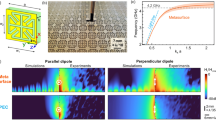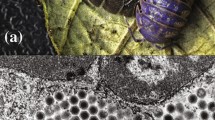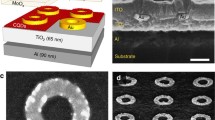Abstract
Transformation optics (TO) is a new tool for controlling electromagnetic fields. In the context of metamaterial technology, it provides a direct link between a desired electromagnetic (EM) phenomenon and the material response required for its occurrence. Recently, this powerful framework has been successfully exploited to study surface plasmon assisted phenomena such as light harvesting. Here, we review the general strategy based on TO to design plasmonic devices capable of harvesting light over a broadband spectrum and achieving considerable field confinement and enhancement. The methodology starts with two-dimensional (2D) cases, such as 2D metal edges, crescent-shaped cylinders, nanowire dimers, and rough metal surfaces, and is well extended to fully-fledged three-dimensional (3D) situations. The largely analytic approach gives physical insights into the processes involved and suggests a way forward to study a wide variety of plasmonic nanostructures.
Similar content being viewed by others
References
Anker J N, Hall W P, Lyandres O, et al. Biosensing with plasmonic nanosensors. Nat Mater, 2008, 7: 442–453
Kabashin A V, Evans P, Pastkovsky S, et al. Plasmonic nanorod metamaterials for biosensing. Nat Mater, 2009, 8: 867–871
Brolo A G. Plasmonics for future biosensors. Nat Photon, 2012, 6: 709–713
Wu C H, Khanikaev A B, Adato R, et al. Fano-resonant asymmetric metamaterials for ultrasensitive spectroscopy and identification of molecular monolayers. Nat Mater, 2012, 11: 69–75
Nie S M, Emery S R. Probing single molecules and single nanoparticles by surface-enhanced Raman scattering. Science, 1997, 275: 1102–1106
Kneipp K, Wang Y, Kneipp H, et al. Single molecule detection using surface-enhanced Raman scattering (SERS). Phys Rev Lett, 1997, 78: 1667–1670
Lim D K, Jeon K S, Kim H M, et al. Nanogap-engineerable Raman-active nanodumbbells for single-molecule detection. Nat Mater, 2010, 9: 60–67
Kravets V G, Schedin F, Jalil R, et al. Singular phase nano-optics in plasmonic metamaterials for label-free singlemolecule detection. Nat Mater, 2013, 12: 304–309
Oulton R F, Sorger V J, Zentgraf T, et al. Plasmon lasers at deep subwavelength scale. Nature, 2009, 461: 629–632
Noginov M A, Zhu G, Belgrave A M, et al. Demonstration of a spaser-based nanolaser. Nature, 2009, 460: 1110–1112
Ma R M, Oulton R F, Sorger V J, et al. Room-temperature sub-diffraction-limited plasmon laser by total internal reflection. Nat Mater, 2011, 10: 110–113
Lu Y J, Kim J, Chen H Y, et al. Plasmonic nanolaser using epitaxially grown silver film. Science, 2012, 337: 450–453
Kim S, Jin J H, Kim Y J, et al. High-harmonic generation by resonant plasmon field enhancement. Nature, 2008, 453: 757–760
Zhang Y, Grady N K, Ayala-Orozco C, et al. Three-dimensional nanostructures as highly efficient generators of second harmonic light. Nano Lett, 2011, 11: 5519–5523
Navarro-Cia M, Maier S A. Broad-band near-infrared plasmonic nanoantennas for higher harmonic generation. ACS Nano, 2012, 6: 3537–3544
Stockman M I. Nanofocusing of optical energy in tapered plasmonic waveguides. Phys Rev Lett, 2004, 93: 137404
Ropers C, Neacsu C C, Elsaesser T, et al. Grating-coupling of surface plasmons onto metallic tips: a nanoconfined light source. Nano Lett, 2007, 7: 2784–2788
Moreno E, Rodrigo S G, Bozhevolnyi S I, et al. Guiding and focusing of electromagnetic fields with wedge plasmon polaritons. Phys Rev Lett, 2008, 100: 023901
Volkov V S, Bozhevolnyi S I, Rodrigo S G, et al. Nanofocusing with channel plasmon polaritons. Nano Lett, 2009, 9: 1278–1282
De Angelis F, Das G, Candeloro P, et al. Nanoscale chemical mapping using three-dimensional adiabatic compression of surface plasmon polaritons. Nat Nanotechnol, 2010, 5: 67–72
Zhang J J, Xiao S S, Wubs M, et al. Surface plasmon wave adapter designed with transformation optics. ACS Nano, 2011, 5: 4359–4364
Choo H, Kim M K, Staffaroni M, et al. Nanofocusing in a metal-insulator-metal gap plasmon waveguide with a three-dimensional linear taper. Nat Photon, 2012, 6: 837–843
Pile D F P, Ogawa T, Gramotnev D K, et al. Theoretical and experimental investigation of strongly localized plasmons on triangular metal wedges for subwavelength waveguiding. Appl Phys Lett, 2005, 87: 061106
Choi H, Pile D F P, Nam S, et al. Compressing surface plasmons for nano-scale optical focusing. Opt Express, 2009, 17: 7519–7524
Barnes W L, Dereux A, Ebbesen T W. Surface plasmon subwavelength optics. Nature, 2003, 424: 824–830
Gramotnev D K, Bozhevolnyi S I. Plasmonics beyond the diffraction limit. Nat Photon, 2010, 4: 83–91
Halas N J, Lal S, Chang W S, et al. Plasmons in strongly coupled metallic nanostructures. Chem Rev, 2011, 111: 3913–3961
Rycenga M, Cobley C M, Zeng J, et al. Controlling the synthesis and assembly of silver nanostructures for plasmonic applications. Chem Rev, 2011, 111: 3669–3712
Giannini V, Fernandez-Dominguez A I, Sonnefraud Y, et al. Controlling light localization and light-matter interactions with nanoplasmonics. Small, 2010, 6: 2498–2507
Pendry J B, Schurig D, Smith D R. Controlling electromagnetic fields. Science, 2006, 312: 1780–1782
Kundtz N B, Smith D R, Pendry J B. Electromagnetic design with transformation optics. Proc IEEE, 2011, 99: 1622–1633
Chen H Y, Chan C T, Sheng P. Transformation optics and metamaterials. Nat Mater, 2010, 9: 387–396
Ward A J, Pendry J B. Refraction and geometry in Maxwell’s equations. J Mod Opt, 1996, 43: 773–793
Schurig D, Mock J J, Justice B J, et al. Metamaterial electromagnetic cloak at microwave frequencies. Science, 2006, 314: 977–980
Luo Y, Chen H S, Zhang J J, et al. Design and analytical full-wave validation of the invisibility cloaks, concentrators, and field rotators created with a general class of transformations. Phys Rev B, 2008, 77: 125127
Zhang J J, Luo Y, Mortensen N A. Minimizing the scattering of a nonmagnetic cloak. Appl Phys Lett, 2010, 96: 113511
Li J, Pendry J B. Hiding under the carpet: a new strategy for cloaking. Phys Rev Lett, 2008, 101: 203901
Liu R, Ji C, Mock J J, et al. Broadband ground-plane cloak. Science, 2009, 323: 366–369
Valentine J, Li J S, Zentgraf T, et al. An optical cloak made of dielectrics. Nat Mater, 2009, 8: 568–571
Ergin T, Stenger N, Brenner P, et al. Three-dimensional invisibility cloak at optical wavelengths. Science, 2010, 328: 337–339
Ma H F, Cui T J. Three-dimensional broadband ground-plane cloak made of metamaterials. Nat Commun, 2010, 1: 21
Luo Y, Zhang J J, Chen H S, et al. A rigorous analysis of plane-transformed invisibility cloaks. IEEE Trans Antennas Propag, 2009, 57: 3926–3933
Chen X Z, Luo Y, Zhang J J, et al. Macroscopic invisibility cloaking of visible light. Nat Commun, 2011, 2: 176
Zhang J, Liu L, Luo Y, et al. Homogeneous optical cloak constructed with uniform layered structures. Opt Express, 2011, 19: 8625–8631
Landy N, Smith D R. A full-parameter unidirectional metamaterial cloak for microwaves. Nat Mater, 2013, 12: 25–28
Luo Y, Zhang J J, Wu B I, et al. Interaction of an electromagnetic wave with a cone-shaped invisibility cloak and polarization rotator. Phys Rev B, 2008, 78: 125108
Zhang J J, Luo Y, Chen H S, et al. Cloak of arbitrary shape. J Opt Soc Am B, 2008, 25: 1776–1779
Wee W H, Pendry J B. Super phase array. New J Phys, 2010, 12: 033047
Luo Y, Zhang J J, Chen H S, et al. High-directivity antenna with small antenna aperture. Appl Phys Lett, 2009, 95: 193506
Zhang J J, Luo Y, Mortensen N A. Hiding levitating objects above a ground plane. Appl Phys Lett, 2010, 97: 133501
Kundtz N, Smith D R. Extreme-angle broadband metamaterial lens. Nat Mater, 2010, 9: 129–132
Ma H F, Cui T J. Three-dimensional broadband and broad-angle transformation-optics lens. Nat Commun, 2010, 1: 124
Luo Y, Zhang J J, Ran L X, et al. New concept conformal antennas utilizing metamaterial and transformation optics. IEEE Antenn Wirel Propag Lett, 2008, 7: 508–511
Zhang J J, Luo Y, Chen H S, et al. Manipulating the directivity of antennas with metamaterial. Opt Express, 2008, 16: 10962–10967
Luo Y, Zhang J J, Chen H S, et al. Wave and ray analysis of a type of cloak exhibiting magnified and shifted scattering effect. Prog Electromagn Res, 2009, 95: 167–178
Zhang J J, Luo Y, Mortensen N A. Transmission of electromagnetic waves through sub-wavelength channels. Opt Express, 2010, 18: 3864–3870
Zhang J J, Luo Y, Chen H S, et al. Guiding waves through an invisible tunnel. Opt Express, 2009, 17: 6203–6208
Luo Y, Zhang J J, Chen H S, et al. Cylindrical cloak with axial permittivity/permeability spatially invariant. Appl Phys Lett, 2008, 93: 033504
Luo Y, Zhang J J, Chen H S, et al. Full-wave analysis of prolate spheroidal and hyperboloidal cloaks. J Phys D Appl Phys, 2008, 41: 235101
Zhang J J, Luo Y, Xi S, et al. Directive emission obtained by coordinate transformation. Prog Electromagn Res, 2008, 81: 437–446
Zhang J J, Huangfu J T, Luo Y, et al. Cloak for multilayered and gradually changing media. Phys Rev B, 2008, 77: 035116
Zhang J J, Luo Y, Chen H S, et al. Sensitivity of transformation cloak in engineering. Prog Electromagn Res, 2008, 84: 93–104
Pendry J B, Aubry A, Smith D R, et al. Transformation optics and subwavelength control of light. Science, 2012, 337: 549–552
Liu Y M, Zhang X. Recent advances in transformation optics. Nanoscale, 2012, 4: 5277–5292
Aubry A, Lei D Y, Maier S A, et al. Conformal transformation applied to plasmonics beyond the quasistatic limit. Phys Rev B, 2010, 82: 205109
Fernandez-Dominguez A I, Wiener A, Garcia-Vidal F J, et al. Transformation-optics description of nonlocal effects in plasmonic nanostructures. Phys Rev Lett, 2012, 108: 023901
Fernandez-Dominguez A I, Zhang P, Luo Y, et al. Transformation-optics insight into nonlocal effects in separated nanowires. Phys Rev B, 2012, 86: 241110
Aubry A, Lei D Y, Fernandez-Dominguez A I, et al. Plasmonic light-harvesting devices over the whole visible spectrum. Nano Lett, 2010, 10: 2574–2579
Luo Y, Pendry J B, Aubry A. Surface plasmons and singularities. Nano Lett, 2010, 10: 4186–4191
Mcphedran R C, Perrins W T. Electrostatic and optical resonances of cylinder pairs. Appl Phys, 1981, 24: 311–318
Mcphedran R C, Milton G W. Transport-properties of touching cylinder pairs and of the square array of touching cylinders. Proc R Soc A-Math Phys Eng Sci, 1987, 411: 313–326
Garcia-Vidal F J, Pendry J B. Collective theory for surface enhanced Raman scattering. Phys Rev Lett, 1996, 77: 1163–1166
Xu H X, Aizpurua J, Kall M, et al. Electromagnetic contributions to single-molecule sensitivity in surface-enhanced Raman scattering. Phys Rev E, 2000, 62: 4318–4324
Kottmann J P, Martin O J F. Plasmon resonant coupling in metallic nanowires. Opt Express, 2001, 8: 655–663
Talley C E, Jackson J B, Oubre C, et al. Surface-enhanced Raman scattering from individual Au nanoparticles and nanoparticle dimer substrates. Nano Lett, 2005, 5: 1569–1574
Sweatlock L A, Maier S A, Atwater H A, et al. Highly confined electromagnetic fields in arrays of strongly coupled Ag nanoparticles. Phys Rev B, 2005, 71: 235408
Romero I, Aizpurua J, Bryant G W, et al. Plasmons in nearly touching metallic nanoparticles: singular response in the limit of touching dimers. Opt Express, 2006, 14: 9988–9999
Lassiter J B, Aizpurua J, Hernandez L I, et al. Close encounters between two nanoshells. Nano Lett, 2008, 8: 1212–1218
Atre A C, Garcia-Etxarri A, Alaeian H, et al. A broadband negative index metamaterial at optical frequencies. Adv Optical Mater, 2013, 1: 327–333
Aubry A, Lei D Y, Maier S A, et al. Broadband plasmonic device concentrating the energy at the nanoscale: the crescent-shaped cylinder. Phys Rev B, 2010, 82: 125430
Luo Y, Lei D Y, Maier S A, et al. Broadband light harvesting nanostructures robust to edge bluntness. Phys Rev Lett, 2012, 108: 023901
Luo Y, Aubry A, Pendry J B. Electromagnetic contribution to surface-enhanced Raman scattering from rough metal surfaces: a transformation optics approach. Phys Rev B, 2011, 83: 155422
Wu L Y, Ross B M, Lee L P. Optical properties of the crescent-shaped nanohole antenna. Nano Lett, 2009, 9: 1956–1961
Shumaker-Parry J S, Rochholz H, Kreiter M. Fabrication of crescent-shaped optical antennas. Adv Mater, 2005, 17: 2131–2134
Rochholz H, Bocchio N, Kreiter M. Tuning resonances on crescent-shaped noble-metal nanoparticles. New J Phys, 2007, 9: 53
Bukasov R, Shumaker-Parry J S. Highly tunable infrared extinction properties of gold nanocrescents. Nano Lett, 2007, 7: 1113–1118
Luo Y, Lei D Y, Maier S A, et al. Transformation-optics description of plasmonic nanostructures containing blunt edges/corners: from symmetric to asymmetric edge rounding. ACS Nano, 2012, 6: 6492–6506
Aubry A, Lei D Y, Maier S A, et al. Interaction between plasmonic nanoparticles revisited with transformation optics. Phys Rev Lett, 2010, 105: 233901
Aubry A, Lei D Y, Maier S A, et al. Plasmonic hybridization between nanowires and a metallic surface: a transformation optics approach. ACS Nano, 2011, 5: 3293–3308
Prodan E, Radloff C, Halas N J, et al. A hybridization model for the plasmon response of complex nanostructures. Science, 2003, 302: 419–422
Nordlander P, Prodan E. Plasmon hybridization in nanoparticles near metallic surfaces. Nano Lett, 2004, 4: 2209–2213
Willingham B, Brandl D W, Nordlander P. Plasmon hybridization in nanorod dimers. Appl Phys B-Lasers Opt, 2008, 93: 209–216
Luo Y. Resonant plasmonic nanostructures: transformation optics applied to plasmonics. Dissertation of Doctoral Degree. London: Imperial College London, 2012. 94–106
Fernandez-Dominguez A I, Maier S A, Pendry J B. Collection and concentration of light by touching spheres: a transformation optics approach. Phys Rev Lett, 2010, 105: 266807
Fernandez-Dominguez A I, Luo Y, Wiener A, et al. Theory of three-dimensional nanocrescent light harvesters. Nano Lett, 2012, 12: 5946–5953
Pendry J B, Fernández-Dominguez A I, Luo Y, et al. Capturing photons with transformation optics. Nat Phys, 2013, 9: 518–522
Atay T, Song J H, Nurmikko A V. Strongly interacting plasmon nanoparticle pairs: from dipole-dipole interaction to conductively coupled regime. Nano Lett, 2004, 4: 1627–1631
Hill R T, Mock J J, Urzhumov Y, et al. Leveraging nanoscale plasmonic modes to achieve reproducible enhancement of light. Nano Lett, 2010, 10: 4150–4154
Mock J J, Hill R T, Tsai Y J, et al. Probing dynamically tunable localized surface plasmon resonances of film-coupled nanoparticles by evanescent wave excitation. Nano Lett, 2012, 12: 1757–1764
Brown L V, Sobhani H, Lassiter J B, et al. Heterodimers: plasmonic properties of mismatched nanoparticle pairs. ACS Nano, 2010, 4: 819–832
Huang F M, Wilding D, Speed J D, et al. Dressing plasmons in particle-in-cavity architectures. Nano Lett, 2011, 11: 1221–1226
Cang H, Labno A, Lu C G, et al. Probing the electromagnetic field of a 15-nanometre hotspot by single molecule imaging. Nature, 2011, 469: 385–388
Ciraci C, Hill R T, Mock J J, et al. Probing the ultimate limits of plasmonic enhancement. Science, 2012, 337: 1072–1074
Savage K J, Hawkeye M M, Esteban R, et al. Revealing the quantum regime in tunnelling plasmonics. Nature, 2012, 491: 574–577
Lei D Y, Fernandez-Dominguez A I, Sonnefraud Y, et al. Revealing plasmonic gap modes in particle-on-film systems using dark-field spectroscopy. ACS Nano, 2012, 6: 3537–3544
Hanham S M, Fernandez-Dominguez A I, Teng J H, et al. Broadband terahertz plasmonic response of touching InSb disks. Adv Mater, 2012, 24: 226–230
Isaac T H, Barnes W L, Hendry E. Determining the terahertz optical properties of subwavelength films using semiconductor surface plasmons. Appl Phys Lett, 2008, 93: 241115
Giannini V, Berrier A, Maier S A, et al. Scattering efficiency and near field enhancement of active semiconductor plasmonic antennas at terahertz frequencies. Opt Express, 2010, 18: 2797–2807
Author information
Authors and Affiliations
Corresponding author
Rights and permissions
About this article
Cite this article
Luo, Y., Zhao, R., Fernandez-Dominguez, A.I. et al. Harvesting light with transformation optics. Sci. China Inf. Sci. 56, 1–13 (2013). https://doi.org/10.1007/s11432-013-5031-2
Received:
Accepted:
Published:
Issue Date:
DOI: https://doi.org/10.1007/s11432-013-5031-2




